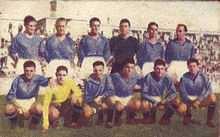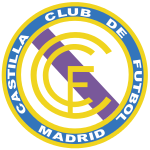football clubhouse
Real Madrid Castilla Club de Fútbol is a spanish football team that plays in Primera División RFEF – Group 2 for the 2021–22 season. It is real number Madrid ‘s reserve team. They play their family games at Alfredo Di Stéfano Stadium with a capacity of 6,000 seats. [ 2 ] Reserve teams in Spain free rein in the like league organization as their elder team rather than a separate league. Reserve teams, however, can not play in the lapp division as their senior team. consequently, Real Madrid Castilla are ineligible for promotion to the Primera División. Reserve teams are besides no long permitted to enter the Copa del Rey. In summation, alone under-23 players, or under-25 players with a professional contract, can switch between aged and reserve teams.
Reading: Real Madrid Castilla – Wikipedia
history [edit ]
 AD Plus Ultra 1949–50
AD Plus Ultra 1949–50
AD Plus Ultra [edit ]
In 1948, Agrupación Deportiva Plus Ultra, a local amateurish team, then playing in the Tercera División, agreed to become a bird feeder golf club for very Madrid. originally formed in 1930, the team took its diagnose from the national motto of Spain. Real gave AD Plus Ultra fiscal support and in refund were given first refusal on the club ‘s best players. By 1949, they made their debut in the Segunda División and in 1952, the club became the official Real reservation team. In 1959, they reached the quarter-finals of the Copa del Rey, losing 7–2 on aggregate to eventual finalists Granada. During the 1950s and 1960s, future senior veridical Madrid players and spanish internationals such as José María Zárraga, Enrique Mateos, Ramón Marsal, Pedro Casado, Juan Manuel Villa, José María Vidal, Fernando Serena and Ramón Grosso all exhausted time at the club, and Juan Alonso finished off his career there. Miguel Muñoz began his coaching career at the club. In 1972, Plus Ultra folded because of the demise of the policy company of the lapp name, and their placement in the Tercera División was taken by Castilla Club de Fútbol, the new military reserve team for Real Madrid, on 21 July .
Castilla CF [edit ]
 Former logo of Castilla. As Castilla CF, the team enjoyed something of a aureate age. During this era, with a team that included Agustín, Ricardo Gallego and Francisco Pineda, Castilla reached the final of the 1979–80 Copa del Rey. During their cup run, they beat four Primera División teams, including Hércules, Athletic Bilbao, Real Sociedad and Sporting de Gijón. [ 3 ] The latter two finally finished moment and one-third in the Primera División. In the final, they played Real Madrid but lost 6–1. Because Real besides won the Primera División, however, Castilla qualified for the 1980–81 european Cup Winners ‘ Cup. Despite beating West Ham United 3–1 in the open game at the Santiago Bernabéu, they lost the render 5–1 after extra fourth dimension and went out in the first round. [ 3 ] Castilla reached the quarter-finals of the Copa del Rey on three foster occasions, in 1984, 1986, and 1988. In 1984, with Amancio Amaro as bus, Castilla won the Segunda División. Amaro ‘s tenure as coach saw the rise of the celebrated La Quinta del Buitre – Emilio Butragueño, Manolo Sanchís, Martín Vázquez, Míchel, and Miguel Pardeza. Castilla were ineligible for promotion, however, because substantial Madrid were already in the Primera División. In the 1987–88 season, they finished third base in the Segunda División, but were once again ineligible for promotion .
Former logo of Castilla. As Castilla CF, the team enjoyed something of a aureate age. During this era, with a team that included Agustín, Ricardo Gallego and Francisco Pineda, Castilla reached the final of the 1979–80 Copa del Rey. During their cup run, they beat four Primera División teams, including Hércules, Athletic Bilbao, Real Sociedad and Sporting de Gijón. [ 3 ] The latter two finally finished moment and one-third in the Primera División. In the final, they played Real Madrid but lost 6–1. Because Real besides won the Primera División, however, Castilla qualified for the 1980–81 european Cup Winners ‘ Cup. Despite beating West Ham United 3–1 in the open game at the Santiago Bernabéu, they lost the render 5–1 after extra fourth dimension and went out in the first round. [ 3 ] Castilla reached the quarter-finals of the Copa del Rey on three foster occasions, in 1984, 1986, and 1988. In 1984, with Amancio Amaro as bus, Castilla won the Segunda División. Amaro ‘s tenure as coach saw the rise of the celebrated La Quinta del Buitre – Emilio Butragueño, Manolo Sanchís, Martín Vázquez, Míchel, and Miguel Pardeza. Castilla were ineligible for promotion, however, because substantial Madrid were already in the Primera División. In the 1987–88 season, they finished third base in the Segunda División, but were once again ineligible for promotion .
real Madrid B [edit ]
In 1991, the Royal Spanish Football Federation banned the use of break names for military reserve teams and Castilla CF became known as Real Madrid Deportiva and then Real Madrid B. In the early 1990s, two former Castilla players, Vicente del Bosque and Rafael Benítez, began their coach careers with the team. In 1997, the team was relegated to the Segunda División B, but despite this, they continued to produce internationally acclaim players. These have included Raúl, Guti and Iker Casillas, who all became established members of the senior Real Madrid team .
real Madrid Castilla [edit ]
In the 2004–05 temper, coach Juan Ramón López Caro guided the team back to the Segunda División and the team subsequently revived the El Castilla name and became known as Real Madrid Castilla. In 2006, the modern stadium of the club ‘s training facilities Ciudad Real Madrid was named the Alfredo Di Stéfano Stadium and Francisco Moreno Cariñena became the first mugwump president in 16 years. In this class, the team besides has continued to produce quality players such as Roberto Soldado and Álvaro Arbeloa. In the 2006–2007 season, the team was relegated to the Segunda División B under the management of ex-Real Madrid caption Míchel after occupying 19th locate in the league in a disappoint season. Míchel received a draw of criticism and accepted all the incrimination for the team ‘s bad performances, specially for those who had a fantastic season in the 2005–06 season, such as Rubén de la Red, Esteban Granero and Javi García. The reserves produced other quality players, including Juan Mata and Álvaro Negredo. real Madrid Castilla was promoted spinal column to the Segunda División at the goal of the season 2011–12 after beating Cádiz in the play-offs with an aggregate of score 8–1 and this year the golf club produced one timbre musician, Dani Carvajal who was sold to Bayer Leverkusen in 2012 before he returned to Real Madrid in 2013 to play in the first team. In the 2013–14 season, three quality players Nacho, Álvaro Morata and Jesé were promoted to the beginning team, and then Castilla was relegated in the last matchday after being defeated by substantial Murcia in the last match of the season. Since 2014 when they played in the one-third division, Castilla continued to produce early quality players, including Lucas Vázquez, Fernando Pacheco, Borja Mayoral, Marcos Llorente, Sergio Reguilón, Óscar Rodríguez and Achraf Hakimi. In the 2019–20 season, the team was coached by Raúl, ex-Real Madrid legend.
Season to season [edit ]
- As AD Plus Ultra
- As Castilla CF
- As a reserve team
european record [edit ]
UEFA Cup Winners’ Cup :
Honours [edit ]
- Winners: 1983–84
- Winners: 1990–91, 2001–02, 2004–05, 2011–12
- Winners: 1948–49, 1954–55, 1956–57, 1963–64, 1965–66, 1967–68
Players [edit ]
current squad [edit ]
- As of 25 August 2021[4][5]
note : Flags indicate national team as defined under FIFA eligibility rules. Players may hold more than one non-FIFA nationality .
note : Flags indicate national team as defined under FIFA eligibility rules. Players may hold more than one non-FIFA nationality .
Out on lend [edit ]
note : Flags indicate national team as defined under FIFA eligibility rules. Players may hold more than one non-FIFA nationality .
Personnel [edit ]
current technical staff [edit ]
| Position | Staff |
|---|---|
| Head coach | Rául González |
| Assistant coach | Santiago Sánchez |
| Goalkeeping coach | Roberto Vázquez |
| Fitness coach | Nacho Sancho |
- Last updated: 1 September 2020
- Source:[6]
former players [edit ]
Coaches [edit ]
Records [edit ]
top Scorers ( All competitions ) [edit ]
Appearances ( All competitions ) [edit ]
stadium [edit ]

celebrated players [edit ]
note : This list includes players that have appeared in at least 100 circus tent league games and/or have reached external condition .
